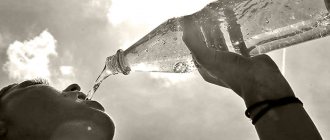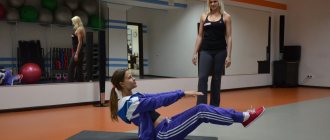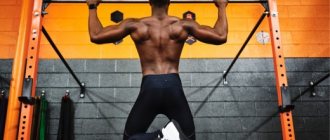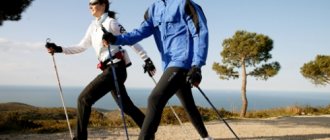Nordic walking
It’s not every day that we manage to lead an active lifestyle, but of course, a combination of physical inactivity, poor nutrition, disruption of work and rest, together with bad habits can lead to a number of serious diseases.
30.01.2020
It’s not every day that we manage to lead an active lifestyle, but, of course, the combination of physical inactivity, poor nutrition, disruption of work and rest, together with bad habits can lead to a number of serious diseases.
- on the part of the cardiovascular system, this can manifest itself as hypertension, myocardial infarction, unstable angina;
- from the endocrine system - obesity, diabetes mellitus, metabolic syndrome;
- from the musculoskeletal system - osteochondrosis, arthrosis, hernia, etc.
- from the nervous system - from a banal deterioration in mood, apathy to the development of deep depression.
In the USA, in the 60s, a study was conducted that assessed how employees of those years and today lead an active lifestyle at work, incl. do physical labor.
It turned out that in the previous century, more than 50% of people were engaged in some kind of physical labor at work; currently, less than 20% of the working population is engaged in physical labor at work. It turned out that there was a decrease in calories spent at work by approximately 142 kcal. According to scientists' calculations, it was assumed that as a result the weight would increase to an average of 80 kg, but in fact it turned out that the weight of employees ranged from 90 kg and above.
As a result, another study was carried out in 2003-2004: more than 6,000 participants were taken and their activity was monitored throughout the day using special sensors.
It turned out that more than 50% of the time people are in a static position, namely sitting. As you know, people spend most of their time in a sitting position - in the workplace, in a car or public transport, and many spend their free time either at the computer or watching TV shows, etc., which as a result leads to disorders in the muscular system.
Various muscle groups begin to react, and one of the most important is the iliopsoas muscle, which originates from the anterior surface of the lumbar region, passes through the pelvic floor and is fixed to the lesser trochanter of the femur. With prolonged static load, this muscle tends to shorten.
As a result of this, there is constant tension in the flexor muscles (quadriceps femoris), the gluteal muscles and abdominal muscles are constantly in a relaxed position, and the position of the internal organs gradually changes; a load appears on the cervicothoracic region, kyphosis forms in the thoracic region; The load also occurs on the visual apparatus, headaches and fatigue appear. When a person stands up, the tense muscles begin to change the center of gravity. This manifests itself as poor posture, pain in the lumbar region, hip and knee joints. The result will be a complex effect on the musculoskeletal system, internal organs and systems.
Therefore, we need to find some kind of golden key to our health that can help all organs and systems at once. This key exists and everyone has known it since childhood - this is walking.
There are several types of walking:
- leisure walking,
- health-improving
- sports.
Walking walking has a slower pace - about 3-4 km/h; Race walking is a high-achieving sport included in the Olympic program. And there remains healthy walking, of which Nordic walking is a representative,
which will be discussed.
I would like to start a conversation about Nordic walking with the famous phrase of Jacques Pesce: “The new is the well-forgotten old.” People have always used sticks for support when necessary.
When traveling long distances, travelers, shepherds, and pilgrims always took a staff with them. Two sticks were originally used to facilitate skiing on snow, as can be seen in rock paintings in Russia and Scandinavia from 2000-1500 BC.
In 30-40 years. In the 20th century, Finnish skiers used ski pole walking in the summer. In the 70s, Finnish skier Juha Mieto was the first to include cross-country ski pole races in his summer training program; such athletes were even called “swamp skiers.” But when analyzing the results of the competition, it turned out that the achievements of these athletes are much higher than those who train using the traditional method, and Juha Mieto himself became an Olympic champion in 1976. Ski coach Mauri Repo was the first to substantiate the effectiveness of walking with poles for training athletes in the summer, describing its anatomical and physiological aspects. And the school teacher, later a professor at the Faculty of Sports Sciences, Leena Jaaskeläinen, actively introduced walking with poles in physical education classes since 1966, as an alternative and safe form of physical activity. This was especially true for students exempted from physical education classes.
In 1987, under her leadership, the first public event with a demonstration of walking with ski poles was held at the Olympic Stadium in Helsinki.
Finnish skier Marco Kantaneva played a major role in the development of Nordic walking. Since the 1990s, he has been developing various techniques for walking with poles, and participated in the development of special poles and a “boot” for asphalt pavement. In 1997, special poles for Nordic walking were released, and this year is considered the year of the emergence of Nordic Walking, in the same year the Nordic Walking Federation (ONWF) was organized. Gradually, Nordic walking moved from Finland to Scandinavia, Europe, and from there to the USA, Saudi Arabia, China and Russia. Today, more than 12 million people in the world are engaged in agriculture, and in Russia there are already more than 2 million “Scandinavians”
In 1992, the first study was conducted in Oregon, which involved 86 overweight women. They were divided into three groups: the first group did standard aerobics, the second group did walking, and the third group did Nordic walking. The purpose of the study was to assess exercise tolerance, muscle endurance and “quality of life” of the participants. After 12 weeks, it was proven that the parameters of physical fitness (in metabolic units), muscle endurance (assessed by dynamometers) and “quality of life” (mood swings were noted in a specially designed questionnaire). According to the testing results, it was Nordic walking that took first place in these indicators, after which a number of more studies were conducted. It was found that as a result of using special sticks, the shoulder girdle is included in the work, due to the involvement of more muscles (80-90%), kcal loss increases, muscle tone improves, and efficiency and safety for many categories of athletes increases. SH began to be used as metabolic training, prevention and treatment of dorsopathies.
In 2010, Nordic walking officially appeared in Russia, schools and clubs for Nordic walking enthusiasts are actively opening, and in recent years this direction has begun to be considered as a method of exercise therapy and rehabilitation. International symposiums are actively held to discuss the use of Nordic walking in cardiac rehabilitation, treatment of diabetes, obesity, osteoporosis, diseases of the musculoskeletal system, treatment of children with bronchial asthma, women with urinary tract diseases, people with gerontological diseases
.
Nordic walking is the optimal and most physiological type of aerobic physical activity for healthy people and people with health problems, including those without training experience and the elderly.
It has virtually no contraindications and does not require special equipment, but compared to regular walking, it is a more complex coordination type of physical activity.
With regular physical activity, the body's resistance to the influence of unfavorable environmental factors, as well as those associated with psycho-emotional stress, increases.
Against the background of general improvement of the body, optimal physical activity helps to increase the functional reserves of the cardiovascular and respiratory systems, reduces morbidity and, therefore, mortality of the population.
The effectiveness of Nordic walking has been confirmed by numerous scientific studies confirming the effective functioning of the muscles of the upper limbs during training.
Nordic walking retains all the advantages of regular walking over another type of popular exercise - running, which is especially important for people with health conditions, including cardiovascular diseases, obesity, joint and back pain, and the elderly.
Compared to running, any walking does not have a large “impact” load on the spine and joints,
severe shortness of breath, excessive increase in blood pressure and pulse. The use of special poles during Nordic walking reduces the load on the joints and spine by 15%, connects the muscles of the upper limbs, shoulder girdle and torso to work, increasing the body’s energy consumption and thereby increasing the metabolic effect.
Nordic walking is a more balanced and more energy-intensive form of exercise than running. When running, mainly the leg muscles are involved, 45% of the muscles are involved in the work, and 300 kcal are spent per hour.
When practicing Nordic walking, more than 80% of the body's muscles are involved, and energy consumption per hour is 700 kcal.
According to these indicators, Nordic walking surpasses even cycling, which uses only half the muscles of the body, and energy consumption is 500 kcal. Due to the active work of the muscles of the upper shoulder girdle during exercise, the cervical and cervicothoracic spine is strengthened.
Nordic walking is an effective and safe form of physical rehabilitation for patients with cardiovascular diseases, since during exercise its reserves increase: the stroke volume of the heart, minute volume of blood circulation, and physical performance increase.
It has been proven that outdoor exercise increases the synthesis of endorphins and serotonin.
A study was also conducted among people susceptible to depression confirming that outdoor activities restore strength faster and reduce stress and depression.
Many years of research have proven that with proper training, Nordic walking exercises have a positive effect on the entire body as a whole.
From the cardiovascular side - economization of myocardial work (decrease in heart rate at rest and increase in stroke volume), increase in elasticity and density of the vascular wall, decrease and normalization of blood pressure, decrease in cholesterol levels, stimulation of extracardiac circulatory factors (diaphragm, gastrocnemius and soleus muscles), improvement of blood supply to organs.
On the part of the nervous system – improvement of cerebral circulation, normalization of excitation and inhibition processes, expansion of the plasticity of the nervous system, beneficial effect on mental activity, formation of permanent motor skills, development of dexterity, speed and accuracy of movements.
Muscular system - improving muscle nutrition, increasing the intensity of redox processes, increasing the number of mitochondria in cells, thickening and increasing the strength of ligaments and tendons, improving communication between internal organs and systems (proprioception).
Skeletal system - increasing the strength of bones, compacting cartilage tissue, increasing the range of motion in joints, improving musculoskeletal function, ensuring the anatomically correct position of internal organs (discussed above using the example of a position at the workplace).
From the senses – the development of proprioceptive sensitivity (perception of one’s body in space), the inclusion of deep muscle stabilizers.
Genitourinary system – improved excretory function, improved regulation of acid-base balance, improved blood supply to the kidneys.
Digestive system - increased secretory function, increased gastrointestinal motility, improved nutrition of the walls of the stomach and intestines, increased insulin resistance.
Respiratory system - increase in vital capacity (increase in the captured volume of oxygen), decrease in respiratory rate, increase in blood oxygen saturation.
Thus, we can conclude that Nordic walking is comprehensively useful, accessible regardless of gender and age, and can be used as an alternative type of physical activity in physical education classes in schools.
Nordic walking actively develops such qualities as strength, agility, flexibility, endurance and speed.
Nordic walking has no special contraindications, except for general contraindications to exercise therapy - ARVI, heart defects, valvular insufficiency grades 3 and 4, hypertension 3.
In any case, having decided to engage in Nordic walking, you must consult with your doctor.
Nordic walking does not require expensive or bulky equipment; you only need special poles, clothing that does not restrict movement, or a tracksuit; shoes should be selected in size and eliminate the possibility of calluses, which is especially important for people with diabetes.
Scandinavian poles are different from ski and trekking poles. They have a special removable lanyard, which is worn like a mitten and conveniently secures the hand; handle made of rubber or cork; the shaft of the stick can be solid or made of several sections. At the bottom there is a metal tip for walking on soft ground and a rubber boot for better shock absorption and reduced shock load on the joints of the upper limbs when walking on hard surfaces. The length of the pole is selected using special formulas, taking into account the walker’s height, health status and training goals.
For a positive effect, the correct technique of the Scandinavian step, determining the target heart rate limits, monitoring your condition before and after the lesson, and competent construction of the workout itself are important. Classes should be conducted under the guidance of an instructor who will teach the correct technique and competently structure the lesson. It has been proven that when all factors are observed, Nordic walking has a positive effect on all body systems.
In Russia, there has been a Voluntary Physical Culture Union for several years, headed by Olympic medalist, seven-time European figure skating champion Irina Slutskaya. The main projects of the Union - “Walk, Russia!”, “Woman and a Healthy Lifestyle”, Irina Slutskaya’s Nordic Walking School, “Live, Conquering Diabetes!”, are taking place throughout Russia with her direct participation.
“Health is the most important thing we have. Preserving and increasing it is our main task. We are convinced that a healthy lifestyle, physical education and sports will help citizens strengthen and maintain their health. And our task is to help them with this” - Irina Slutskaya.
International symposia and Meetings are organized, where doctors, instructors and simply Nordic walking enthusiasts share their experience, research results in the prevention, treatment and rehabilitation of various diseases and injuries.
The scientific expert of the Union is a doctor in physical therapy, assistant at the Department of Sports Medicine and Medical Rehabilitation of Sechenov University, head of the Rehabilitation and Recovery Complex of the Scandinavian Health Center, author and director of the Nordic-health project, author and teacher of the Theory and Methods of Nordic Walking program . Instructor in Nordic walking" at the National Institute of Biomedicine, author of Russia's first advanced training course for doctors "Nordic walking in rehabilitation" Kristina Volodina.
The Nordic-health project became one of the first projects in our country to summarize and adapt advanced theoretical and practical developments in the field of Nordic walking. Kristina Andreevna Volodina, for the first time in Russian practice, was able to combine the medical and sports aspects, combined with personal experience in professional sports and coaching, and developed unique methods of training and teaching Nordic walking. All instructors of the Voluntary Physical Education Union project were trained under her leadership.
A Nordic walking course has been opened in Domodedovo, led by medical workers who have undergone special training. You can sign up for a class by phone
The article uses materials from the Nordic-health project with the consent of the author of the project, Kristina Volodina.
- Share
Comprehensive treatment in the center
- Backache
- Scoliosis
- Flat feet
- Spinal hernia
- Osteochondrosis
- Arthrosis
- Radiculitis
- Neuralgia
- Diabetes
- Obesity
- Heart arythmy
- Chronic fatigue syndrome
Choose a path to try to go backwards
Trying to run backwards is certainly doable, but it would be safer to use a treadmill or elliptical. This may sound like a dangerous way to run with all the changing variables such as speed and those around us. But a treadmill offers handrails and a stable place for you to improve your ability to run backwards.
If you are familiar with walking and/or running on a treadmill, you should still approach it with caution. Start by jogging at a slow speed (starting at 1 km per hour) and then move on to a more brisk walk (about 3 km per hour).
If you feel a little out of control, slow down. Focus on each individual step and focus on each step instead of getting ahead of yourself. Remember that safety comes first. Start small and then increase the intensity as you become more comfortable.
running back
As you progress at higher speeds on the treadmill, you can try to start moving backwards. This version of running actually puts less stress on the knees than traditional running, making it ideal for those struggling with knee pain. When driving backwards, it is even more important to make safety a priority. Use the handrails on the treadmill as needed.
If you have access to a treadmill (indoor or outdoor), it can act as an alternative. Many gyms have indoor tracks. Also, check to see if your local school has a track at the stadium. It may be open to the public when schoolchildren are not in session.
Next steps
Finding your rhythm through daily exercise isn't all that bad. But all your hard work and time spent in the gym can often be used more effectively if you change up your workout. Adding a few minutes of reverse walking to your routine can be challenging and fun. Bring a buddy with you to make it double the fun.
At first, everyone feels a little weird and stupid walking or running backwards. But soon you will feel the satisfaction of different muscles participating in new ways.
Safety comes first, especially for a workout like this. Pay attention to every step, you must get used to walking (running) like this.
To summarize, we can say that this workout is suitable for anyone who wants to play sports, improve their health and try something new. Try walking (running) backwards!
Sources
- ncbi.nlm.nih.gov/…/22503882 (English)
- ncbi.nlm.nih.gov/…/15776337 (English)
Updated: August 2021.











